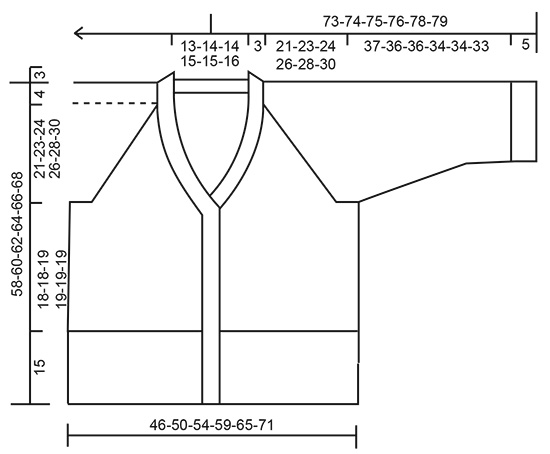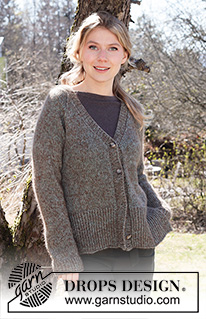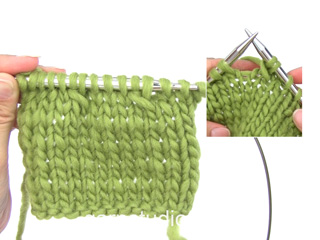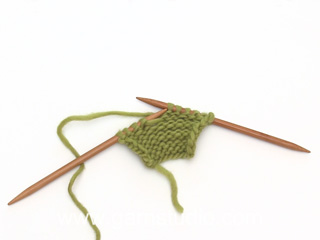North Woods |
|
 |
 |
Knitted jacket with raglan in DROPS Sky and DROPS Kid-Silk. Piece is knitted with V- neck and vent. Size: S - XXXL
DROPS 216-21 |
|
|
------------------------------------------------------- EXPLANATION FOR THE PATTERN: ------------------------------------------------------- GARTER STITCH (back and forth): Knit all rows. 1 ridge vertically = knit 2 rows. DECREASE TIP (evenly): To calculate how to decrease evenly, use the total number of stitches on row (e.g. 91 stitches), minus edge stitches (2 stitches) and divide the remaining stitches by number of decreases to be done (e.g. 16) = 5.6. In this example decrease by knitting alternately approx. every 4th and 5th stitch and every 5th and 6th stitch together. INCREASE TIP (applies to sleeves): Work until 2 stitches remain before marker thread, 1 yarn over, knit 4 (marker thread is in the middle of these stitches), 1 yarn over. On next round knit yarn overs twisted to avoid holes. Then work the new stitches in stocking stitch. RAGLAN: Decrease 2 stitches in every transition between body and sleeves as follows: Work until 1 stitch remains before stitch with marker, slip 2 stitches knitwise, knit 1, pass the 2 slipped stitches over stitch worked (= 2 stitches decreased). BUTTONHOLES: Decrease for buttonholes on right band (when garment is worn). 1 buttonhole: Make 1 yarn over, knit the next 2 stitches together. On next row knit yarn over to make holes. Decrease first buttonhole approx. 4-5-5-5-5-5 cm from bottom of body, then decrease the next 3 buttonholes approx. 9½-9½-10-10-10-10 cm apart. Adjust so that top buttonhole is placed approx. 1 cm below decrease until V-neck begins. ------------------------------------------------------- START THE PIECE HERE: ------------------------------------------------------- JACKET - SHORT OVERVIEW OF THE PIECE: Work front and back piece back and forth separately until rib at the bottom is done. Then slip all parts on to same circular needle and work back and forth from mid front up to armhole. Work sleeves in the round on double pointed needles/a short circular needle. Then slip sleeves on to same circular needle as body and work yoke back and forth from mid front. Finally pick up stitches for band and work back and forth. BACK PIECE: Cast on 91-101-109-117-129-141 stitches (including 1 edge stitch in garter stitch in each side) on circular needle size 4 mm with 1 strand Sky and 1 strand Kid-Silk (= 2 strands). Purl 1 row from wrong side. Then work rib as follows: ROW 1 (= right side): 1 edge stitch in GARTER STITCH - read explanation above, * knit 1 twisted, purl 1 *, work from *-* until 2 stitches remain on needle, knit 1 twisted and finish with 1 edge stitch in garter stitch. ROW 2 (= wrong side): 1 edge stitch in garter stitch, * purl 1 twisted, knit 1 *, work from *-* until 2 stitches remain on row, purl 1 twisted and finish with 1 edge stitch in garter stitch. Repeat 1st and 2nd row until rib measures 15 cm. Cut the yarn and slip stitches on a stitch holder. Put piece aside and work the front pieces. LEFT FRONT PIECE: Cast on 47-51-55-59-65-71 stitches (including 1 edge stitch in garter stitch in each side) on circular needle size 4 mm with 1 strand Sky and 1 strand Kid-Silk (= 2 strands). Purl 1 row from wrong side. Then work rib as follows: ROW 1 (= right side): Work 1 edge stitch in garter stitch, * knit 1 twisted, purl 1 *, work from *-* until 2 stitches remain on needle, knit 1 twisted and finish with 1 edge stitch in garter stitch. ROW 2 (= wrong side): Work 1 edge stitch in garter stitch, * purl 1 twisted, knit 1 *, work from *-* until 2 stitches remain on row, purl 1 twisted and finish with 1 edge stitch in garter stitch. Repeat 1st and 2nd row until rib measures 15 cm. Cut the yarn and slip stitches on a stitch holder. Put piece aside and work the right front piece. RIGHT FRONT PIECE: Work the same way as on left front piece until piece measures 15 cm – adjust to finish after a row from wrong side. Do not cut the yarn. BODY: Now work parts together. Work over right front piece from right side as follows: 1 edge stitch in garter stitch, knit the next 45-49-53-57-63-69 stitches and decrease at the same time 8-9-10-10-11-12 stitches evenly over these stitches, knit last stitch on right front piece together with first stitch on back piece (= 1 stitch decreased), knit the next 89-99-107-115-127-139 stitches on back piece and decrease at the same time 17-21-23-23-25-27 stitches evenly, knit last stitch on back piece together with first stitch on left front piece (= 1 stitch decreased), knit the next 45-49-53-57-63-69 stitches and decrease at the same time 8-9-10-10-11-12 stitches evenly over these stitches, work last stitch in garter stitch = 150-162-174-190-210-230 stitches. Switch to circular needle size 5.5 mm. Continue back and forth in stocking stitch with 1 edge stitch in garter stitch in each side towards mid front. REMEMBER THE KNITTING TENSION! When piece measures 33-33-34-34-34-34 cm from cast on edge, cast off stitches for armholes in each side as follows: Work the first 34-37-39-43-47-51 stitches as before (= right front piece), cast off the next 8-8-10-10-12-14 stitches (= armhole), work the next 66-72-76-84-92-100 stitches (= back piece), cast off the next 8-8-10-10-12-14 stitches (= armhole), work the last 34-37-39-43-47-51 stitches (= left front piece). Put piece aside and work the sleeves. SLEEVES: Cast on 46-48-50-52-52-56 stitches on double pointed needles size 4 mm with 1 strand Sky and 1 strand Kid-Silk (= 2 strands). Now work in the round as follows: Knit 1 round. Then work rib (= knit 1 twisted/purl 1) in the round for 5 cm. Knit 1 round while decreasing 8-8-8-8-8-10 stitches evenly = 38-40-42-44-44-46 stitches. Switch to double pointed needles size 5.5 mm. Insert a marker thread at beginning of round (= mid under sleeve). Move the marker thread when working; it is used for increase under sleeve later. Work in stocking stitch in the round. When piece measures 11-10-10-10-7-7 cm from cast-on edge, increase 1 stitch on each side of marker thread - read INCREASE TIP. Increase like this approx. every 3-3-2½-2-2-2 cm 10-10-12-13-15-15 times in total = 58-60-66-70-74-76 stitches. When sleeve measures 42-41-41-39-39-38 cm (shorter measurements in the larger sizes because of wider neck and longer yoke), cast off 8-8-10-10-12-14 stitches under sleeve (i.e. 4-4-5-5-6-7 stitches on each side of marker thread) = 50-52-56-60-62-62 stitches. Put piece aside and knit another sleeve the same way. YOKE: Slip sleeves on to same circular needle as body where armholes were cast off = 234-250-266-290-310-326 stitches. Work first row from right side as follows: 1 edge stitch in garter stitch, knit the next 30-32-34-38-41-44 stitches, insert 1 marker in next stitch, knit the next 54-58-62-66-70-72 stitches (= sleeve), insert 1 marker in next stitch, knit the next 60-64-68-76-82-88 stitches (= back piece), insert 1 marker in next stitch, knit the next 54-58-62-66-70-72 stitches (= sleeve), insert 1 marker in next stitch, knit the next 30-32-34-38-41-44 stitches, 1 edge stitch in garter stitch (= left front piece). Stitches with markers indicate transition between body and sleeves. Continue back and forth in stocking stitch with 1 edge stitch in garter stitch in each side towards mid front. Then decrease for raglan and V-neck as explained below. RAGLAN: When 4-4-2-2-2-2 rows have been worked, begin decrease for RAGLAN – read explanation above. Decrease like this every other row 19-21-23-25-27-29 times in total. V-NECK: When 2-4-4-4-4-4 rows have been worked on yoke, begin to decrease for V-neck from right side as follows: Work 1 edge stitch in garter stitch, slip 1 stitch knitwise, knit 1, pass slipped stitch over the last stitch worked (= 1 stitch decreased), work until 3 stitches remain, knit the next 2 stitches together (= 1 stitch decreased), work 1 edge stitch in garter stitch. Decrease like this one more time after 7 rows and then on every 4th row 8-9-9-10-11-12 times = 10-11-11-12-13-14 decreases in total for V-neck on each side. When all decreases for raglan and V-neck are done, 62-60-60-66-68-66 stitches remain on row. Work next row from right side as follows: 1 edge stitch in garter stitch, slip 1 stitch knitwise, knit 1, pass slipped stitch over (= 1 stitch decreased), knit the next 56-54-54-60-62-60 stitches - decrease at the same time 12-8-8-12-13-9 stitches evenly, knit the next 2 together (= 1 stitch decreased), 1 edge stitch in garter stitch = 48-50-50-52-53-55 stitches. Cast off. RIGHT BAND: Begin from right side at the bottom of right front piece with circular needle size 4 mm and 1 strand in each quality (= 2 strands). Pick up 135-145 stitches inside 1 edge stitch in garter stitch along right front piece all the way up to mid back on back piece (number of stitches must be divisible by 2 + 1 stitch). Purl 1 row from wrong side - increase with yarn overs where first decrease began by working as follows: * Purl 1, make 1 yarn over *, work from *-* 2 times (= 2 stitches increased) - on next row work yarn overs twisted to avoid holes. Now work rib as follows from right side: Work 1 edge stitch in garter stitch, * knit 1, purl 1 *, work from *-* until 2 stitches remain on needle, knit 1 and finish with 1 edge stitch in garter stitch. Continue rib back and forth like this until band measures 1-1½ cm. Decrease for BUTTONHOLES – read explanation above. Continue with rib until band measures 3-3½ cm in total. Cast off stitches with knit over knit and purl over purl. LEFT BAND: Begin from right side mid back of neck with circular needle size 4 mm and 1 strand in each quality (= 2 strands). Pick up 135-145 stitches inside 1 edge stitch in garter stitch along the edge and down left front piece (number of stitches must be divisible by 2 + 1 stitch). Purl 1 row from wrong side - increase with yarn overs where first decrease began by working as follows: * Purl 1, make 1 yarn over *, work from *-* 2 times (= 2 stitches increased) - on next row work yarn overs twisted to avoid holes. Now work rib as follows from right side: Work 1 edge stitch in garter stitch, * knit 1, purl 1 *, work from *-* until 2 stitches remain on needle, knit 1 and finish with 1 edge stitch in garter stitch. Continue rib back and forth like this until band measures approx. 3-3½ cm - adjust length according to right band. Cast off stitches with knit over knit and purl over purl. ASSEMBLY: Sew bands together mid back of neck inside 1 edge stitch in garter stitch in each side. Sew the buttons on to left band. Sew the openings under the sleeves together. |
|

|
|
|
Have you made this or any other of our designs? Tag your pictures in social media with #dropsdesign so we can see them! Do you need help with this pattern?You'll find tutorial videos, a Comments/Questions area and more by visiting the pattern on garnstudio.com. © 1982-2024 DROPS Design A/S. We reserve all rights. This document, including all its sub-sections, has copyrights. Read more about what you can do with our patterns at the bottom of each pattern on our site. |
|






































































Comments / Questions (19)
No entiendo el ranglan y donde pone marcadores
04.12.2023 - 23:41Buongiorno, nella spiegazione dello sprone risulta che ci sono 58 maglie per le maniche (quindi 58x2= 116), 64 maglie per il dietro e 32 maglie per i due davanti (quindi 64). Sommando tutte le maglie 116+64+64 +2magli di vivagno mi risultano 246maglie non 250. Dove sono le altre 4 maglie? Grazie Piera
23.10.2023 - 17:59DROPS Design answered:
Buonasera Piera, ha inserito i segnapunti dello sprone NELLE maglie con indicato? e non TRA le maglie? Le 4 maglie che mancano sono quelle con i segnapunti. Buon lavoro!
23.10.2023 - 22:24Bonjour, pouvez-vous m’éclairer sur les diminutions raglan pour ce modèle : faudrait-t-il diminuer à 2mailles avant le marqueur et pas de diminution après le marqueur, parce qu’il est écrit : Tricoter jusqu’à ce qu’il reste 1 maille avec le marqueur... Merci d’avance et merci aussi pour les jolis modèles proposés.
21.03.2022 - 22:10DROPS Design answered:
Bonjour Mme Anh, vous diminuez 2 mailles à chaque marqueur soit 8 mailles au total, commencez quand il reste 1 maille avant le fil marqueur, glissez 2 mailles à l'endroit (la maille avant le marqueur + celle avec le marqueur), tricotez 1 maille endroit (= celle après le marqueur), et passez les 2 mailles glissées par-dessus la maille tricotée = vous avez diminué 2 mailles: 1 maille avant + 1 maille après le marqueur. Bon tricot!
22.03.2022 - 10:14Vraag 2 Raglan wordt gebreid door 2 steken over te halen. Is dat in iedere naald (dus ook averecht). Dit staat bij 'raglan'. Of alleen als er recht gebreid wordt? In iedere naald is het resultaat namelijk heel anders dan de foto.
18.01.2022 - 22:26DROPS Design answered:
Dag Marijke,
De raglanminderingen worden om de naald gemaakt (iedere andere naald), dus de ene naald wel en de andere naald niet.
21.01.2022 - 09:05Vraag 1: Vanaf de beschrijving 'pas' moeten er in maat L totaal 266 steken op de naald zijn. Dat klopt. Maar in de eerste rij, waar de markeerdraaden ingevoegd moeten worden kom ik op een totaal van 262 steken (inclusief kantsteken). Hoe moet de verdeling precies?
18.01.2022 - 22:25DROPS Design answered:
Dag Marijke,
Je voegt de markeerdraden in de steken, niet tussen de steken. Waarschijnlijk zorgt dit voor het verschil van 4 steken.
21.01.2022 - 09:02Buenas, en la talla M, al montar todos los puntos en la misma aguja, frente, mangas y espalda pone que hay 250 puntos. Pero con las piezas relizadas anteriormente son 246; donde pongo los marcadores?
13.01.2022 - 18:30DROPS Design answered:
Hola Goretti, en las partes anteriores has obtenido 52 puntos en cada manga (= 104 puntos), 37 para cada delantero (= 74 puntos) y 72 puntos en la espalda. En total son 250 puntos. Los marcapuntos se ponen en la transición entre la manga y el cuerpo.
16.01.2022 - 23:20Voor de mouw in de grootste maat 56 st. opgezet. 10 st. minderen is 46 st. 15 x 1 st. aan beide zijden meerderen is 30 st. Totaal 76 st. 14 st. afkanten is 62 st. Bij de pas begin staat na de St. van het VP de 72 st. opnemen. Dit staat hij allebei de moeten. Zie ik iets over het hoofd?
29.12.2021 - 18:40DROPS Design answered:
Dag Henny,
Na het afkanten van steken voor het armsgat op het lijf, heb je 51 steken op beide voorpanden en 100 steken op het achterpand. Met de 62 steken van beide mouwen kom je op een totaal van 326 steken. Zo te zien wordt de raglanlijn ietsje verschoven, dus er gaan a.h.w. steken van de mouwen naar de het lijf. Let er op dat je de markeerdraden in de steken plaatst en niet tussen de steken. Daarnaast brei je nog aan elke kant een kantsteek. Zo klopt het totaal aantal steken weer.
06.01.2022 - 10:55Bonjour, J’aimerai faire ce cardigan uniquement avec 1 qualité de laine (je veux remplacer la Sky par de la Karisma pour l’assortir à un short). Combien de pelotes je vais devoir utiliser et est ce que la taille de mon ouvrage va changer ou bien je continue de suivre les indications indépendamment de cela? Merci !
23.10.2021 - 12:04DROPS Design answered:
Bonjour Lily, quelle taille faites-vous? Deuxieme question, voulez-vous utiliser DROPS Kid-Silk ou non?
25.10.2021 - 12:52Hei! Under V-hals står det "fell slik igjen etter 7 pinner. " Mener dere da 7 pinner etter fellingen før, eller 7 pinner etter man har satt sammen ermene og bolen på en pinne?
22.05.2021 - 09:28DROPS Design answered:
Hei Inga. 2. fellingen starter7 pinner etter 1.fellingen. Når du har satt sammen til bærestykket skal det strikkes 2-4-4-4-4 eller 4 pinner på bærestykket (avhengig av hvilken str du strikker), så starter fellingen til v-hals. mvh DROPS design
26.05.2021 - 09:15Dann wäre meine Frage natürlich noch, ob ich das Modell 216-21, auch mit 1 Faden Air stricken kann? Herzlichen Dank
11.04.2021 - 14:20DROPS Design answered:
Siehe vorrige Antwort :)
12.04.2021 - 10:02